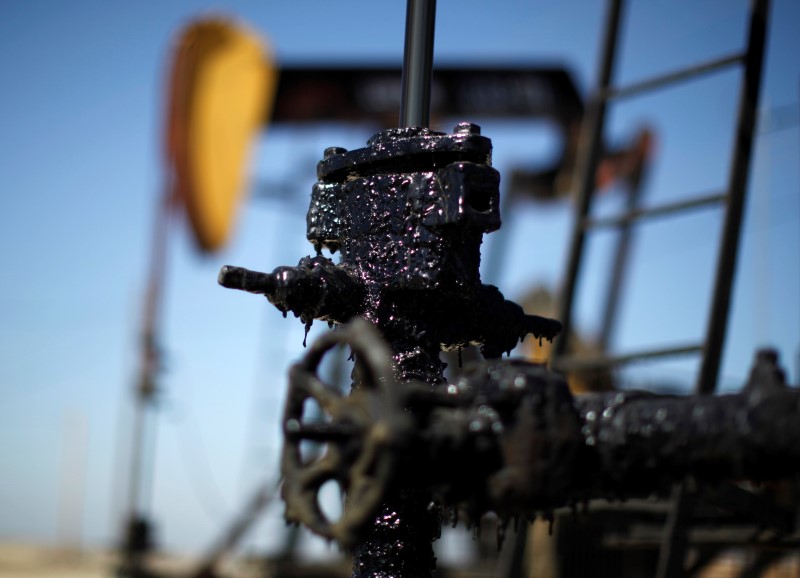By Chen Aizhu and Muyu Xu
SINGAPORE/BEIJING (Reuters) - China's top energy producers will grow their natural gas output this year by twice as much as in the previous oil rout even as they slash spending due to collapsing oil prices, company officials and analysts said.
The world's top energy consumer is forecast to expand its natural gas production by 5% or more in 2020 despite plans for deep spending cuts which will likely curb local oil production, they said.
That would be half the growth in 2019 but double the 2.2% growth seen in 2016 following a lengthy oil slump.
China's state-owned energy companies are joining others worldwide in slashing expenditure after this year's 56% drop in oil prices as a global pandemic ravaged economic activity.
As the country's oil and gas trio plan double digit spending cuts, they are prioritising gas development at home particularly as the market is relatively insulated from sharp oil moves due to government subsidies.
"Under the capital expenditure cuts, companies are revising their gas strategy from an earlier aggressive push to a more practical approach, as gas production remains profitable," said Zhu Kunfeng, Beijing-based associate director at IHS Markit.
PetroChina (SS:601857), Sinopec (NYSE:SHI) Corp (SS:600028) and CNOOC Ltd (HK:0883) said in April they would reduce spending by roughly 20% to 30%, similar to the cuts they made in the last oil rout in 2015/2016.
(Graphic: Chinese oil majors' E&P spending link: https://fingfx.thomsonreuters.com/gfx/ce/xegvbkeejpq/nocspending.png)
Against this backdrop, China's main energy firms are focusing on developing gas and stablising oil at home, while decreasing overseas spending on costly projects such as oil sands and shale gas in North America.
The rise in gas output would also help offset some of the hefty losses these firms have incurred from paying higher prices for gas imports than current market value, prices set out in long-term contracts years ago.
China has boosted gas investment in recent years under a massive anti-pollution drive to replace coal with the lower-carbon gas.
It has also sought to unlock the kind of unconventional resources that have transformed the United States into the world's top gas producer and a leading exporter in the recent decade.
GAS OUTPUT
The bulk of the growth will come from tight gas and shale gas, resources that require unconventional technology like hydraulic fracking to prop open rock shales to allow gas to escape.
PetroChina and Sinopec, which together pump more than 90% of domestic gas, are set to accelerate drilling at top basins including Ordos in north China, Tarim basin in the northwest and Sichuan in the southwest.
PetroChina and Sinopec were not immediately available to comment.
(Graphic: Chinese oil majors' domestic natural gas output link: https://fingfx.thomsonreuters.com/gfx/ce/azgvomllmvd/NOCGAS.png)
An oil executive at Changqing in Ordos, China's largest gas field, said gas output there is expected to reach a record 41.4 billion cubic metres (bcm) this year, 2.2% higher versus 2019, by launching nearly 1,000 new production wells.
"The message across PetroChina is to accelerate productions from new wells and enhancing recoveries at older wells," said the executive based in Changqing, who declined to be named due to company policy.
Companies will also step up developing top shale gas blocks in Sichuan province, making the most of low-cost domestically honed technology and local services and operational expertise like shortened drilling speed.
Chen Zhu, managing director at SIA Energy, estimated shale and tight gas will rise by a combined 7 bcm in 2020 - which will account for nearly 80% of the total gas increment this year.
In China's regulated gas market, energy companies receive subsidies for producing uncoventional gas and are allowed to sell them at market-driven rates, thus shielding gas from being immediately impacted by any oil downturn.
MILDER CUT IN OIL
In addition to keeping the production of natural gas going, analysts expect China's top energy firms to try to minimize the impact of widespread spending cuts on local oil output.
Analysts at consultancies Wood Mackenzie, Rystad Energy and IHS Markit forecast China's domestic crude oil output may drop 3%-5%, or roughly 133,000 barrels per day this year.
(Graphic: Chinese oil majors' domestic oil output link: https://fingfx.thomsonreuters.com/gfx/ce/xlbpgnyybvq/NOCCRUDE.png)
PetroChina, which announced the deepest cut in capital expenditure among China's top three energy producers, could lower its crude oil output by 4% a year for the next three years, Woodmac's principal analyst Max Petrov estimated.
But the forecasts are all smaller than the 7% fall in Chinese domestic crude production seen during the last oil rout when crude prices fell to a low of under $30 in early 2016.
That is in part because companies have become more experienced in managing output declines by using more sophisticated drilling techniques, analysts said.
Meanwhile Chinese energy firm CNOOC Ltd aims to keep domestic oil production at the same level as 2019. It expects oil to average $30-$40 a barrel this year and company officials say most of its projects will break even or win a small profit at those levels.
(Graphic: China crude oil and natural gas output IMAGE link: https://fingfx.thomsonreuters.com/gfx/ce/xlbpgnybjvq/oil%20and%20gas%20output%202005-2020.JPG)
